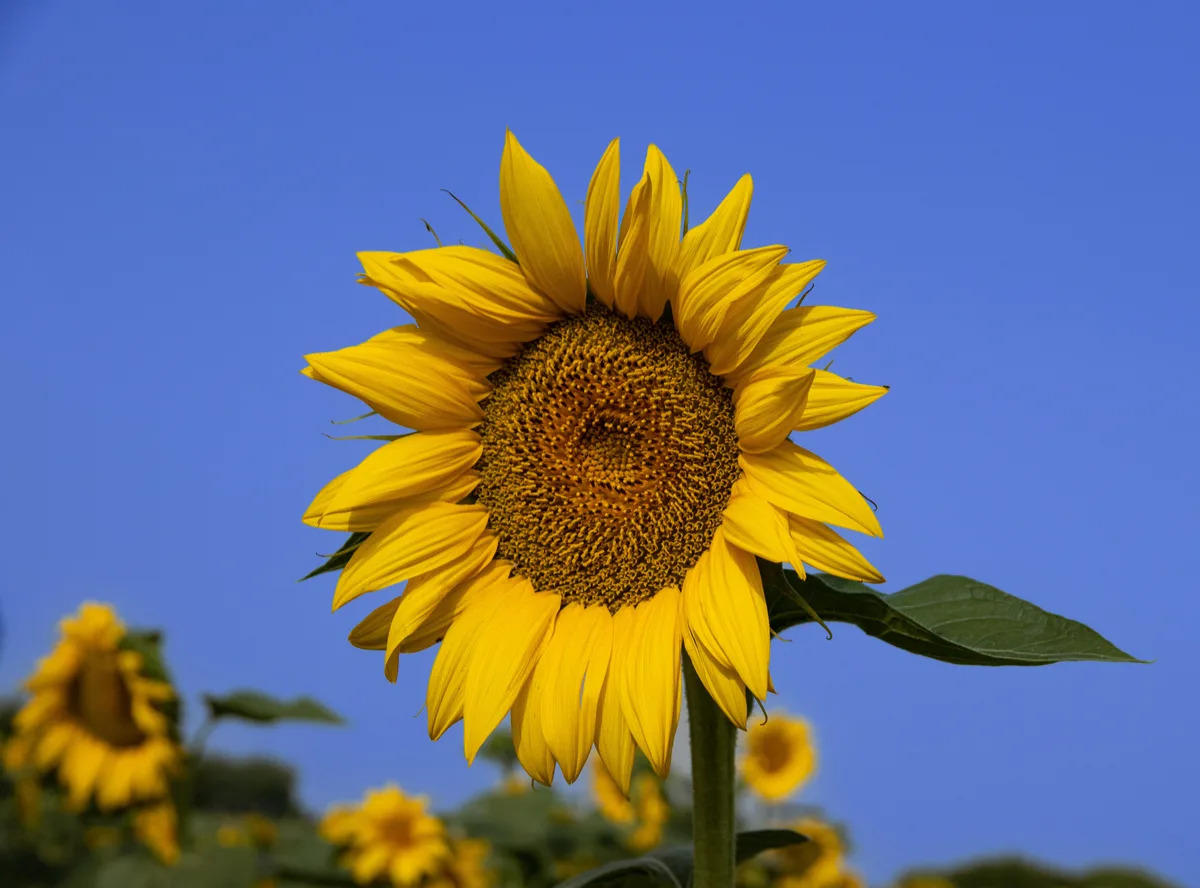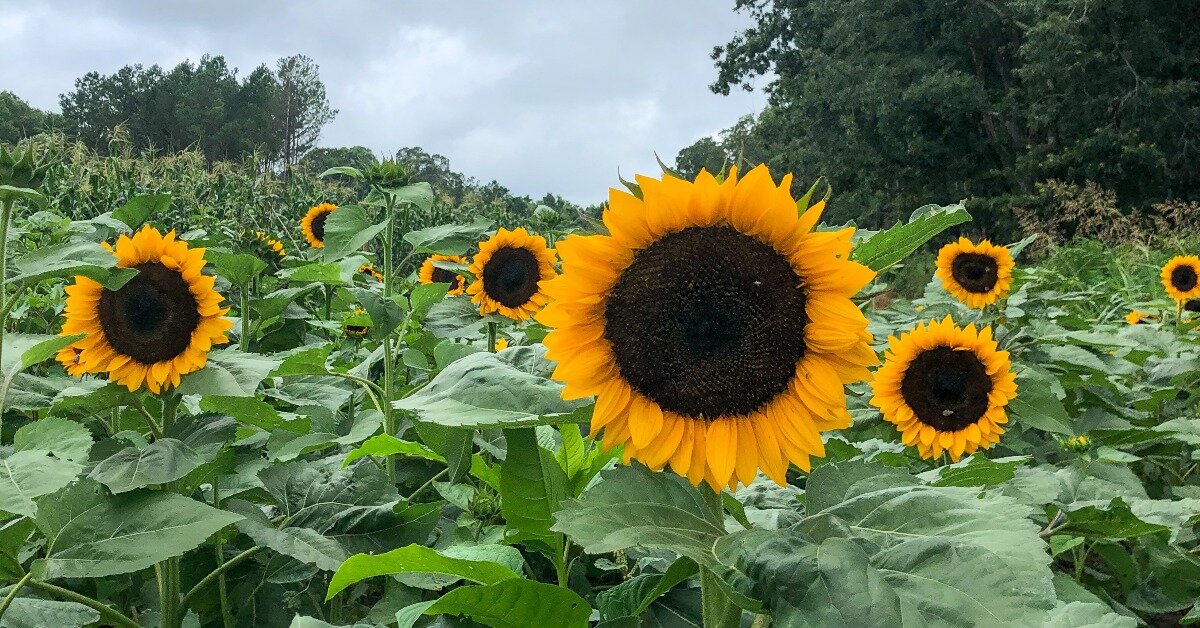Home>Types of Gardening>Ornamental Gardening>Where Do Sunflowers Face


Ornamental Gardening
Where Do Sunflowers Face
Modified: January 22, 2024
Discover the best ornamental gardening tips for sunflowers. Find out where sunflowers face and how to create a stunning display in your garden.
(Many of the links in this article redirect to a specific reviewed product. Your purchase of these products through affiliate links helps to generate commission for Chicagolandgardening.com, at no extra cost. Learn more)
Table of Contents
Introduction
Welcome to the wonderful world of ornamental gardening, where beauty and creativity abound. One of the most fascinating plants you can grow in your garden is the sunflower. With their radiant yellow petals and towering height, sunflowers are a popular choice for gardeners looking to add a splash of vibrant color and natural elegance to their outdoor spaces.
But have you ever wondered why sunflowers always seem to face towards the sun? It’s a remarkable trait that sets them apart from other plants and makes them truly captivating. In this article, we will explore the intriguing phenomenon of sunflower movement and delve into the factors that influence their orientation.
So, if you’re ready to uncover the secrets behind the sunflower’s ability to track the sun’s movement and face it throughout the day, then read on!
Before we delve into the intricate details, it’s important to note that sunflower movement is not limited to a simple static position. Sunflowers have the remarkable ability to move and respond to environmental cues.
The Sunflower’s Ability to Move
Unlike many other plants, sunflowers have the unique ability to move throughout the day, adjusting their position to face the sun. This movement, known as heliotropism, is a remarkable adaptation that allows sunflowers to maximize their exposure to sunlight.
The ability of sunflowers to move is mainly due to their flexible stem. While the stem provides the plant with essential support, it also allows for movement in response to environmental stimuli. Sunflowers are heliotropic, meaning they track and follow the sun’s movement across the sky. This ensures that their leaves and flowers receive the optimal amount of sunlight for photosynthesis and growth.
When a sunflower is young, its stem is more flexible and responsive to changes in sunlight. As the sun rises in the east, the sunflower will orient itself to face the sun, and as the sun moves across the sky throughout the day, the sunflower will gradually adjust its position to continuously face the sun. This constant movement is what gives sunflowers their iconic reputation.
It is important to note that sunflowers exhibit different degrees of movement, depending on their stage of growth and environmental conditions. Younger, more flexible sunflowers will typically display more pronounced movement, while older, more mature sunflowers may exhibit less movement due to their sturdier stems.
So, how exactly do sunflowers move and track the sun’s movement? The process involves a complex interplay between various factors, including sunlight, hormones, and circadian rhythms. Let’s explore these factors in more detail to gain a deeper understanding of sunflower movement.
Factors Influencing Sunflower Orientation
The orientation of sunflowers is influenced by several factors, working together to determine their positioning throughout the day. These factors include sunlight, gravity, internal hormonal control, and environmental conditions.
Sunlight is the primary driver of sunflower orientation. As the sun moves across the sky, sunflowers are able to sense and respond to the direction and intensity of sunlight. They possess specialized cells in their leaves and stem that can detect changes in light levels. This enables them to adjust their positioning to maximize their exposure to sunlight, which is crucial for photosynthesis and growth.
Gravity also plays a role in sunflower orientation. Sunflowers have a natural inclination to grow upward towards the sky, with their stems facing vertically. This helps them efficiently capture sunlight throughout the day. However, sunflowers may exhibit slight variations in their orientation due to gravitational force, especially if they are growing on uneven terrain.
Internal hormonal control is another factor that influences sunflower orientation. Auxin, a plant hormone, is responsible for various growth processes, including the bending and elongation of plant cells. In sunflowers, auxin distribution is affected by sunlight. When exposed to light, auxin accumulates on the shaded side of the stem, causing the cells on that side to elongate more than the cells on the sunny side. This results in the bending of the stem towards the light source, allowing the sunflower to face the sun.
Environmental conditions, such as temperature, moisture, and wind, can also impact sunflower orientation. These factors can influence the growth and flexibility of the sunflower’s stem, affecting its ability to move and adjust its position. For example, wind can cause the stem to sway, leading to a change in orientation. Similarly, extreme temperatures or dehydration can affect the plant’s overall health and its ability to respond to sunlight.
Understanding these factors gives us insight into the remarkable adaptability of sunflowers. By responding to sunlight, gravity, hormonal signals, and environmental conditions, sunflowers are able to optimize their positioning to capture the maximum amount of sunlight and thrive in their surroundings.
Heliotropism: Sunflower’s Attraction to the Sun
Heliotropism is the phenomenon in which sunflowers exhibit a natural attraction and orientation towards the sun. This unique behavior is what sets sunflowers apart from many other plants and makes them a fascinating subject of study for botanists and garden enthusiasts alike.
Heliotropism in sunflowers is primarily driven by the need for optimum sunlight exposure. Sunlight is essential for photosynthesis, the process by which plants convert sunlight into energy. By facing the sun, sunflowers can maximize their ability to capture and convert sunlight into the energy they need to grow and thrive.
To understand how heliotropism works, it’s important to delve into the biology of sunflowers. Sunflowers have specialized cells called photoreceptors, which are located in the leaves and stem. These photoreceptors are sensitive to changes in light intensity and direction. When exposed to sunlight, these cells send signals to the plant’s growth hormones, triggering a series of responses that result in the movement and reorientation of the sunflower towards the sun.
During the early stages of a sunflower’s growth, the stem is more flexible, allowing it to move and adjust its position more easily. As the sun rises in the east, the sunflower will begin facing the direction of the sun. Throughout the day, the sunflower’s stem will gradually tilt and bend, following the sun’s movement across the sky. This constant tracking allows sunflowers to maintain their face towards the sun, ensuring maximum exposure to sunlight.
It’s interesting to note that while sunflowers exhibit a strong attraction towards the sun, they do not simply turn towards it. Instead, they undergo a type of movement called solar tracking, where they adjust their orientation to maintain a constant face towards the sun. This allows sunflowers to capture sunlight from different angles as the sun moves overhead, optimizing their energy production.
Heliotropism in sunflowers is a remarkable adaptation that ensures their survival and success in various environments. By following the path of the sun, sunflowers can maximize their energy intake, enhancing their growth and reproductive capabilities. This unique behavior not only makes sunflowers a captivating addition to any garden but also serves as a reminder of the extraordinary ways in which plants are intricately connected to their surroundings.
Circadian Rhythms and Sunflower Movement
Sunflower movement is not only influenced by external factors like sunlight but also by internal biological processes, particularly circadian rhythms. Circadian rhythms are internal biological clocks that govern various physiological processes in plants and animals, including sleep-wake cycles, hormone production, and metabolism.
In the case of sunflowers, their circadian rhythms regulate their movement and orientation throughout the day. These internal clocks dictate when certain physiological responses occur, such as the bending and reorientation of the stem in response to sunlight.
The circadian rhythm of sunflowers is closely tied to the perception of light. Specialized protein molecules called photoreceptors, present in sunflowers’ leaves and stem, detect changes in light intensity and communicate this information to the plant’s internal clock. This allows sunflowers to anticipate the movement of the sun and adjust their orientation accordingly.
Research has shown that the circadian rhythm of sunflowers is influenced by the genes responsible for controlling various aspects of plant growth and development. These genes interact with the photoreceptors to regulate the production and distribution of growth hormones, such as auxin, which play a crucial role in sunflower movement.
Throughout the day, the circadian rhythm of sunflowers acts as a timing mechanism, coordinating the movement and orientation of the plant in response to changing light conditions. It ensures that sunflowers are able to face the sun during the daytime, allowing for optimal photosynthesis and energy production.
In addition to governing sunflower movement, circadian rhythms also influence other aspects of a sunflower’s life cycle, such as the timing of flowering. These internal biological clocks help synchronize important events in a sunflower’s growth and reproduction with the external environment, ensuring the most favorable conditions for pollination and seed production.
It’s important to note that while circadian rhythms play a significant role in sunflower movement, they can also be influenced by external factors, such as temperature, humidity, and environmental cues. These factors can modify the timing and amplitude of the circadian rhythm, leading to variations in sunflower movement patterns.
Overall, the interaction between the circadian rhythm and external environmental factors shape the fascinating movement and orientation of sunflowers. It is a testament to the intricate and harmonious relationship between plants and their surroundings.
Sunflower Movements during Growth Stages
The movement and orientation of sunflowers undergo changes throughout their different growth stages. From their early seedling stage to their towering flowering stage, sunflowers exhibit distinct movement patterns that are closely tied to their growth and developmental processes.
During the seedling stage, when sunflowers are just emerging from the soil, their movement is relatively limited. The young sunflower plants will generally orient themselves towards the direction of the sunlight as they strive to establish themselves and maximize their exposure to sunlight. At this stage, their stems are more flexible, allowing them to adjust their position slightly to face the sun.
As sunflowers continue to grow and develop, their stems become thicker and sturdier. This decrease in stem flexibility coincides with a decrease in sunflower movement. Mature sunflowers tend to exhibit less pronounced movement compared to their younger counterparts. However, this does not mean that they completely stop orienting themselves towards the sun. Even mature sunflowers typically maintain the ability to adjust their positioning to some extent, ensuring they capture as much sunlight as possible.
It is during the flowering stage that sunflower movement becomes particularly captivating. As the sunflower reaches its peak height, it begins to produce beautiful, vibrant flowers. At this stage, the sunflower’s stem undergoes slight adjustments throughout the day to ensure that the face of the flowers is always directed towards the sun.
The movement of the sunflower’s flowers is known as heliotropism. Each individual sunflower head contains a cluster of small individual flowers called florets. These florets arrange themselves in a spiral pattern around the central disk, and they all collectively move and track the sun’s movement. This allows the sunflower to present its colorful flowers to the sun, maximizing pollination opportunities and seed production.
It is fascinating to witness the cyclical pattern of sunflower movement during the growth stages. Young seedlings eagerly reaching for the sun, mature plants adjusting their positioning, and flowering heads following the sun’s path across the sky. The dynamic nature of sunflower movements serves as a testament to the adaptability and resilience of these remarkable plants.
Directional Patterns of Sunflowers
When it comes to the directional patterns of sunflowers, there are a few interesting observations to note. While sunflowers are known to track the sun and maintain a generally forward-facing orientation, they also exhibit slight variations in their directional patterns depending on local conditions and genetic factors.
One common directional pattern observed in sunflowers is a preference for an eastward orientation in the morning. As the sun rises in the east, sunflowers tend to face in that direction, allowing them to capture the early morning sunlight. This eastward orientation at dawn is believed to be influenced by the circadian rhythm and the need to maximize exposure to the first rays of morning light.
As the day progresses and the sun moves across the sky, sunflowers gradually adjust their orientation to follow the sun’s path. They pivot and turn their heads towards the west, aligning themselves with the sun’s trajectory throughout the day. This westward orientation allows sunflowers to receive the maximum amount of sunlight during the peak hours of the afternoon.
Interestingly, sunflowers also exhibit a slight preference for a south-facing orientation. This preference may be explained by the angle of the sun’s rays, as the southern exposure provides a more direct and intense source of sunlight throughout the day. This south-facing tendency can be more pronounced in regions with lower latitudes, where the angle of the sun’s trajectory is steeper.
While the eastward and westward orientation are generally observed in sunflowers, various factors can influence and modify their directional patterns. Genetic factors can play a role in determining the preferred orientation of sunflowers, as different varieties may have distinct tendencies based on their genetic makeup.
In addition, environmental conditions such as wind and shading can cause sunflowers to deviate from their typical directional patterns. Strong winds can cause the sunflower heads to sway, leading to a shifting orientation. Shading from nearby plants or structures can also influence the direction in which sunflowers face, as they may adjust their positioning to maximize exposure to available sunlight.
Overall, while sunflowers tend to track the sun and exhibit an eastward-to-westward orientation, there can be variations and influences that shape their directional patterns. These patterns not only showcase the adaptability of sunflowers but also contribute to their remarkable beauty and ability to thrive in diverse environments.
Sunflower Tracking and Adapting to Sunlight
Sunflowers possess remarkable abilities to track and adapt to sunlight, ensuring that they receive the optimal amount of light for their growth and development. This unique characteristic sets them apart from many other plants and makes them an intriguing subject of study for botanists.
One of the primary ways sunflowers track sunlight is through their heliotropic movement, which allows them to face the sun as it moves across the sky throughout the day. This movement is made possible by their flexible stems and the action of growth hormones, such as auxin.
As the sun rises in the east, sunflowers initially face towards the east, aligning themselves with the direction of the sunlight. Throughout the day, as the sun moves towards the west, sunflowers gradually adjust their orientation, ensuring that their faces are always directed towards the sun. By doing so, they can maximize their exposure to the sun’s rays, which is crucial for photosynthesis and the production of energy.
In addition to the overall movement of the sunflower plant, individual sunflower heads also display tracking behaviors. The arrangement of florets in a spiral pattern allows each sunflower head to track the sun’s movement independently. This enables the sunflower to present its vibrant flowers directly to the sun, optimizing pollination opportunities and ensuring successful seed production.
To adapt to sunlight, sunflowers have evolved additional mechanisms. For instance, the leaves of sunflowers are not only broad but also positioned in a way that allows for maximum interception of sunlight. Their large leaf surface area captures as much sunlight as possible, increasing the efficiency of photosynthesis.
Moreover, sunflower leaves have adaptations to minimize the shadowing effect. The leaves are arranged in a spiral pattern along the stem, which reduces self-shading and allows sunlight to reach lower parts of the plant. This adaptation ensures that all parts of the sunflower receive adequate light, leading to uniform growth and development.
In response to environmental conditions, sunflowers can also exhibit adaptive behaviors. When sunlight is limited or shaded by neighboring plants, sunflowers can elongate their stems to reach above the shading vegetation, ensuring access to sunlight. This elongation process, known as etiolation, is a strategy to maximize light absorption and enhance the sunflower’s chances of survival.
Overall, sunflowers demonstrate incredible tracking and adaptive capabilities that allow them to effectively utilize sunlight for their growth and reproduction. Their heliotropic movement, arrangement of leaves, and ability to elongate are all mechanisms that contribute to their success in capturing light energy. Sunflowers truly exemplify the ability of plants to respond to and utilize their environment to thrive.
Conclusion
Sunflowers, with their iconic beauty and unique characteristics, captivate gardeners and nature enthusiasts alike. Their ability to track and adapt to sunlight is a testament to the remarkable ways in which plants interact with their environment.
Through the phenomenon of heliotropism, sunflowers exhibit a natural attraction and orientation towards the sun, ensuring that their leaves and flowers receive the optimal amount of sunlight for photosynthesis and growth. This movement is driven by a combination of factors, including sunlight, gravity, internal hormonal control, and environmental conditions.
The directional patterns of sunflowers, from their eastward orientation in the morning to their westward-facing position throughout the day, showcase their ability to track the sun’s path across the sky. They also display a slight preference for a south-facing orientation, which maximizes their exposure to intense sunlight.
Circadian rhythms play a crucial role in sunflower movement, synchronizing their internal biological clocks with the external environment. This coordination ensures that sunflowers adjust their orientation at the most opportune times, allowing for efficient energy production and overall growth.
As sunflowers progress through their growth stages, their movement patterns evolve. Seedlings eagerly reach for the sun, mature plants maintain a more stable orientation, and flowering heads dynamically track the sun to optimize pollination and seed production.
Furthermore, sunflowers showcase the ability to adapt to various environmental conditions, such as wind and shading, by making slight adjustments in their orientation and stem elongation to maximize their exposure to sunlight.
In conclusion, sunflowers exemplify the wonders of nature and the intricate relationship between plants and their surroundings. Their ability to track, adapt, and optimize their orientation towards sunlight ensures their survival and allows them to thrive in diverse habitats. As you tend to your ornamental garden, consider incorporating sunflowers to not only add dazzling beauty but also witness firsthand the incredible movements and adaptations of these magnificent plants.










